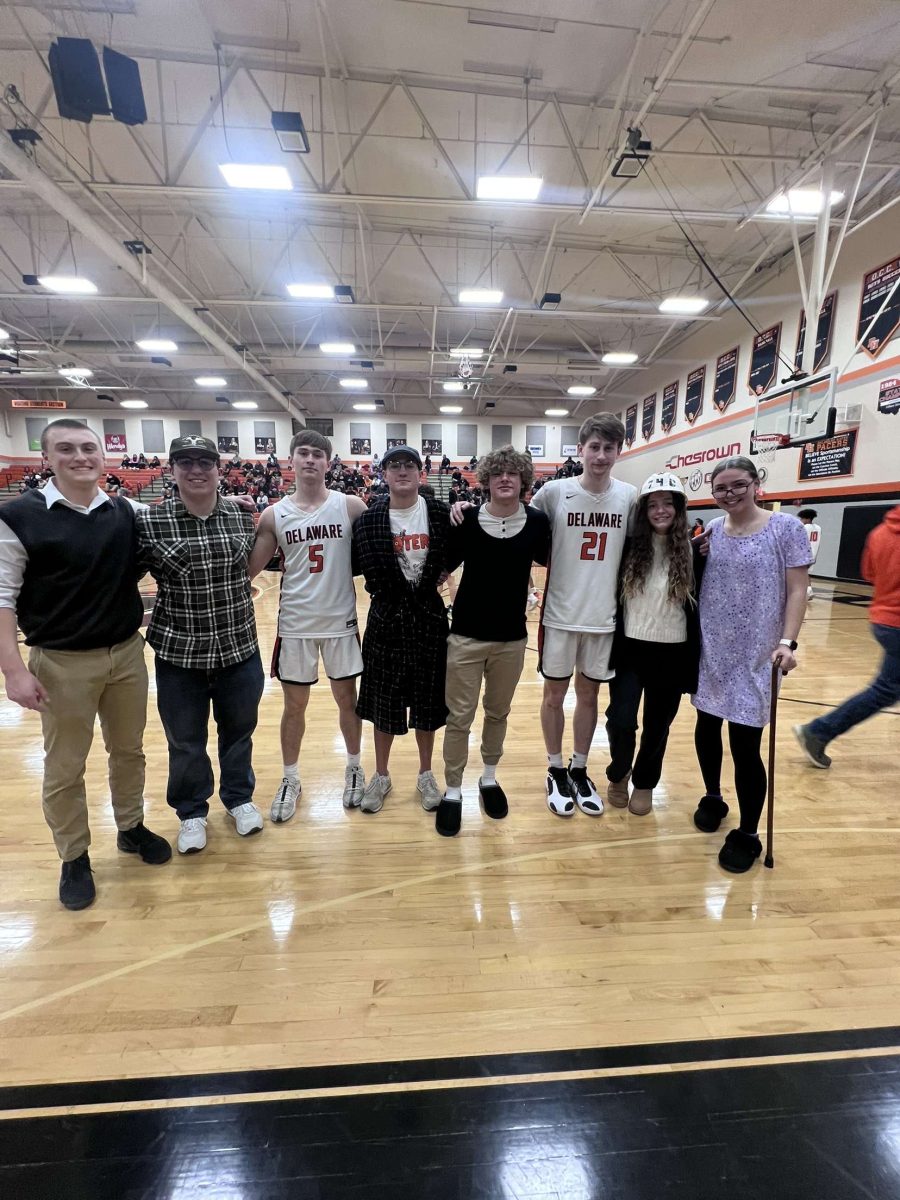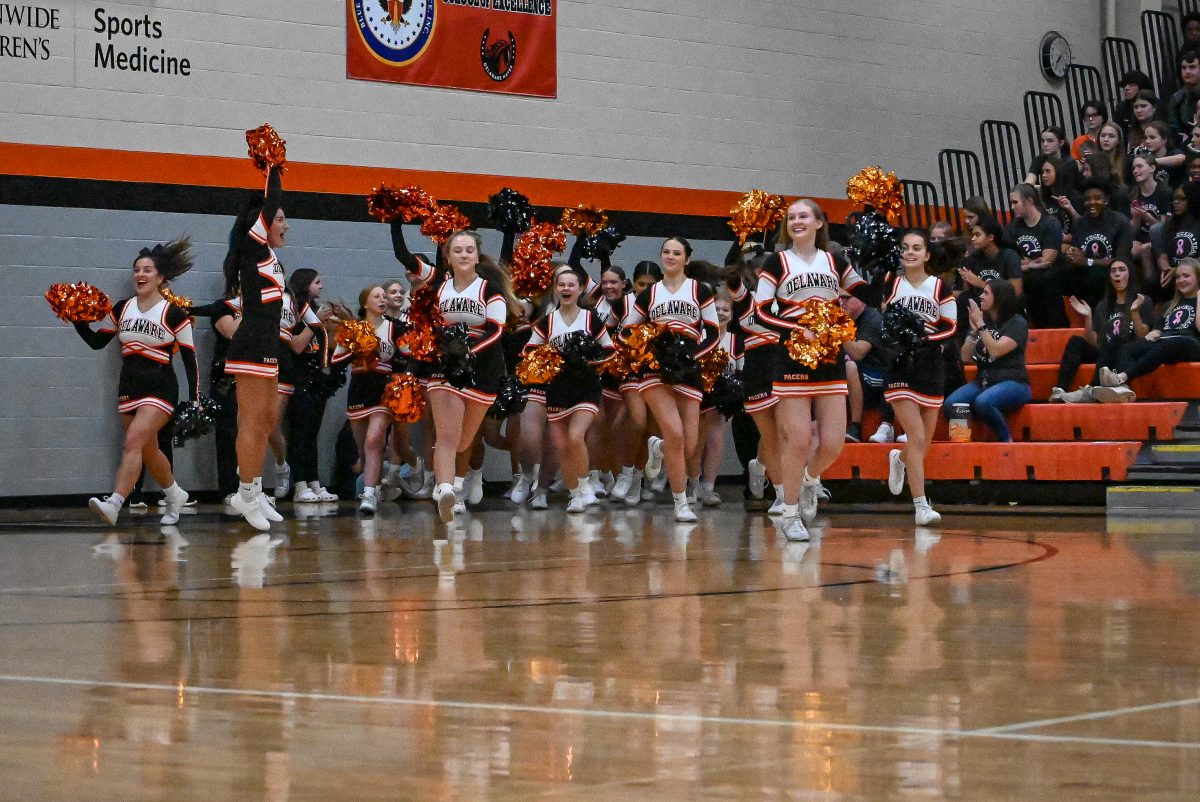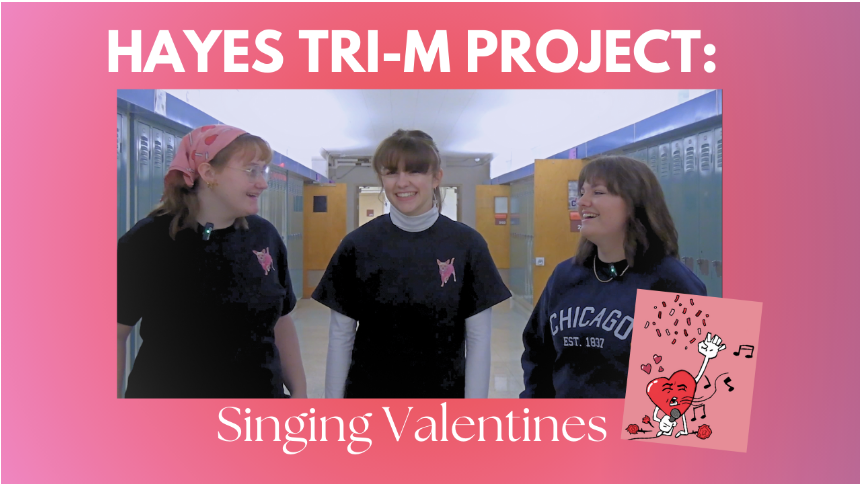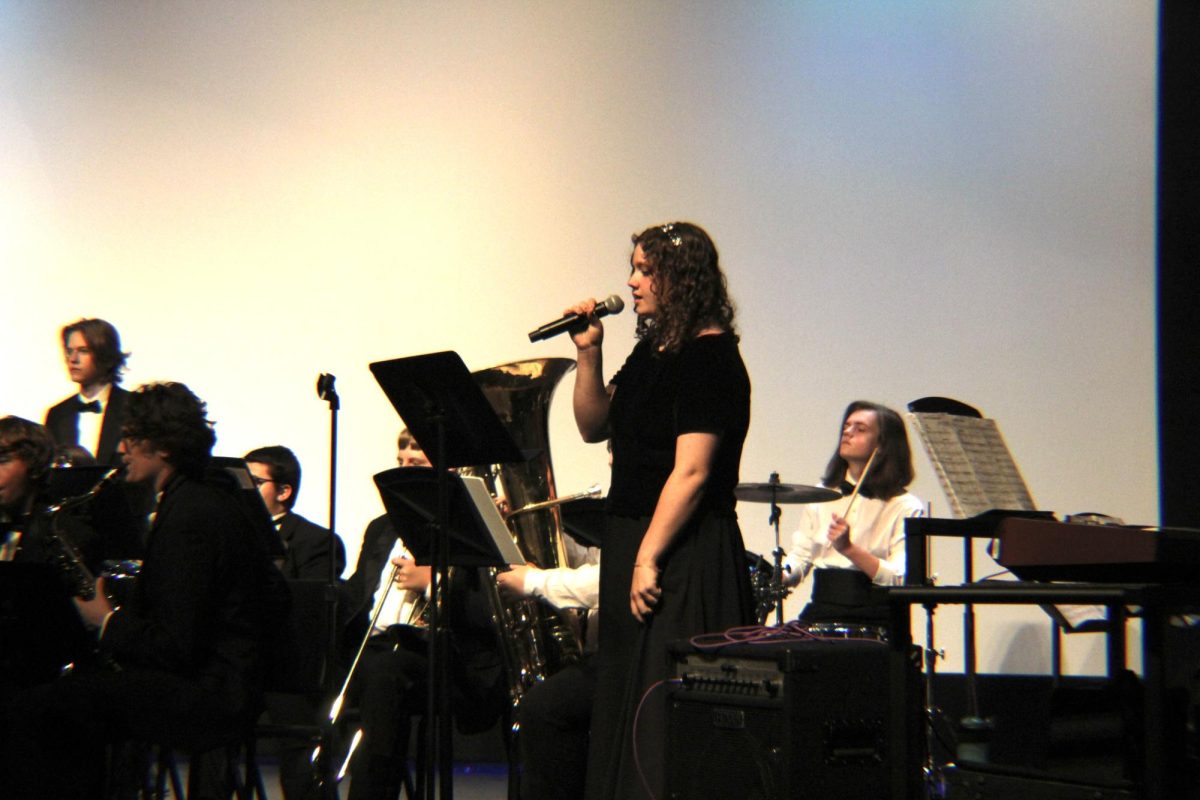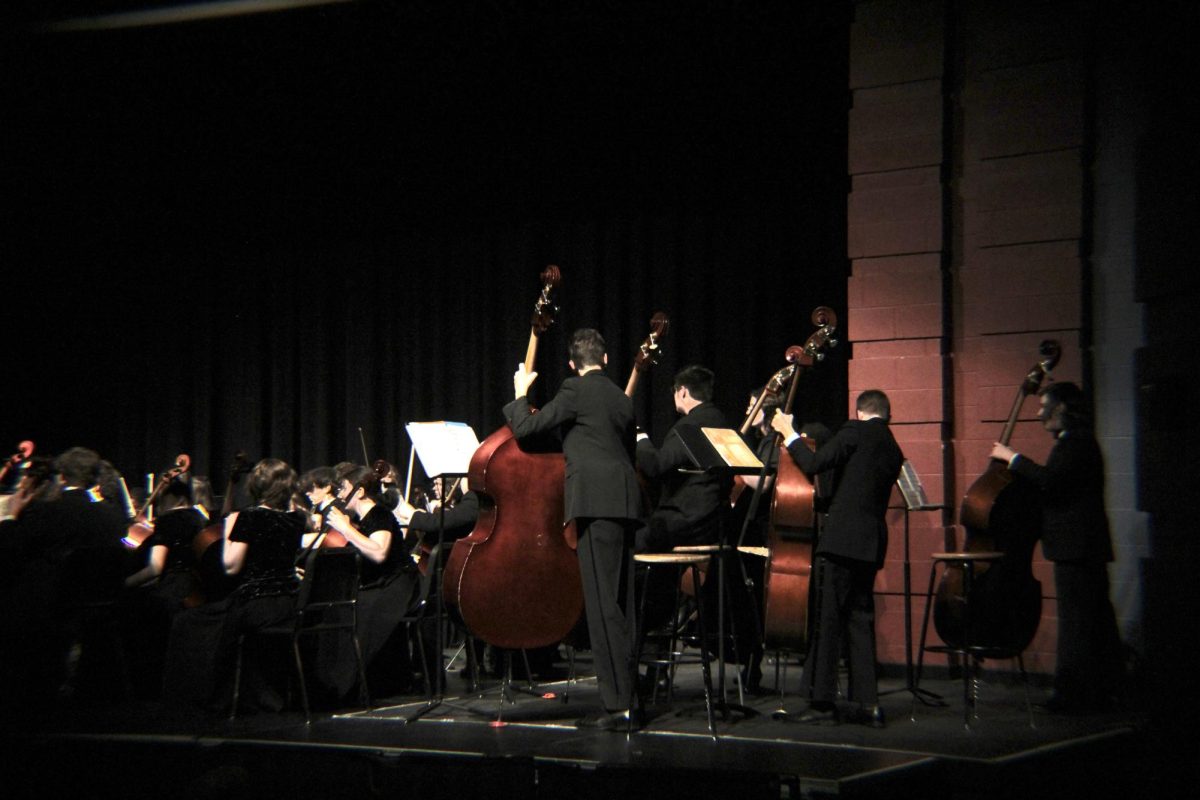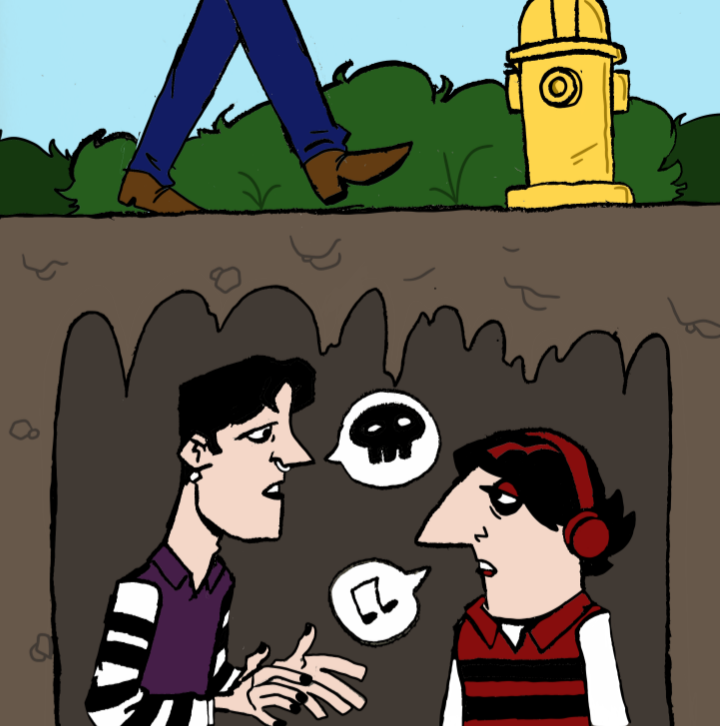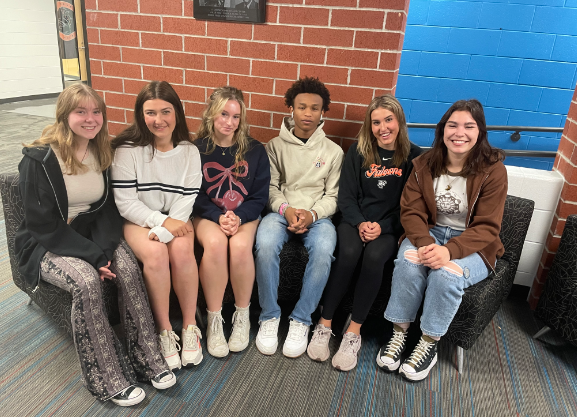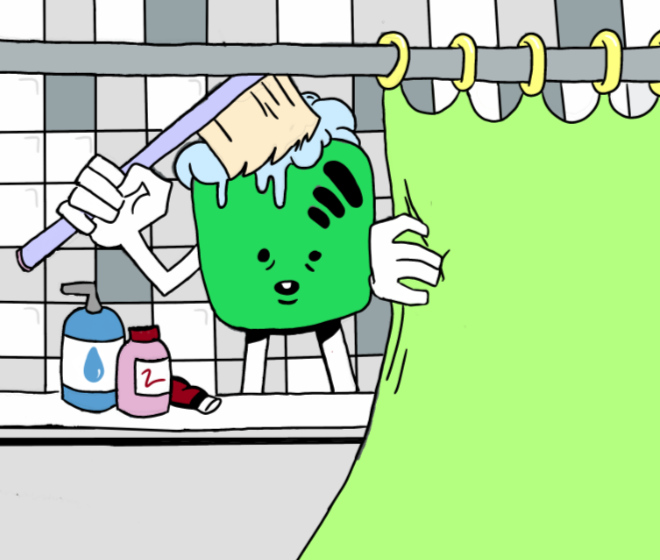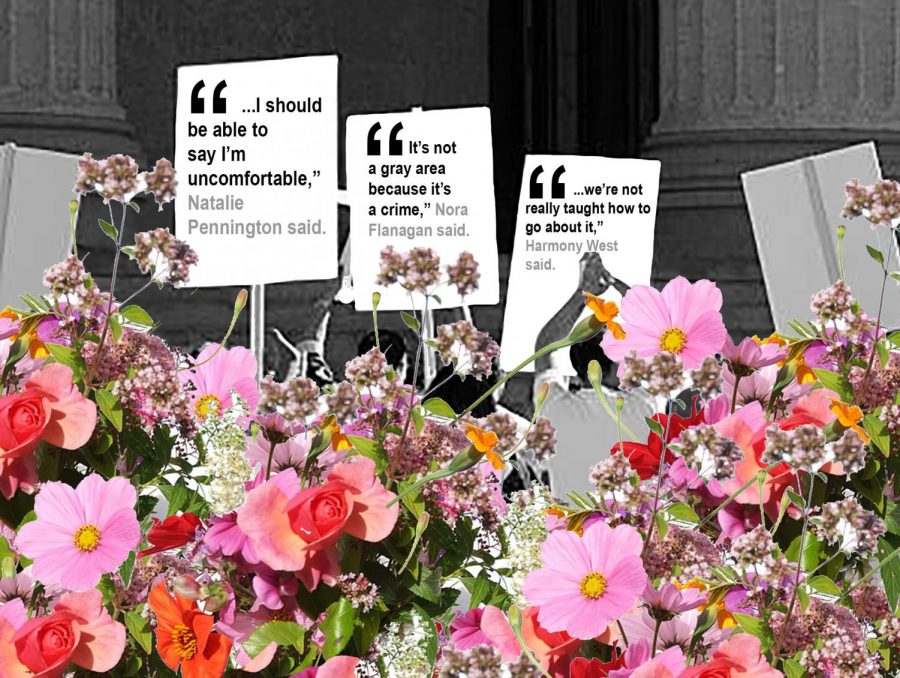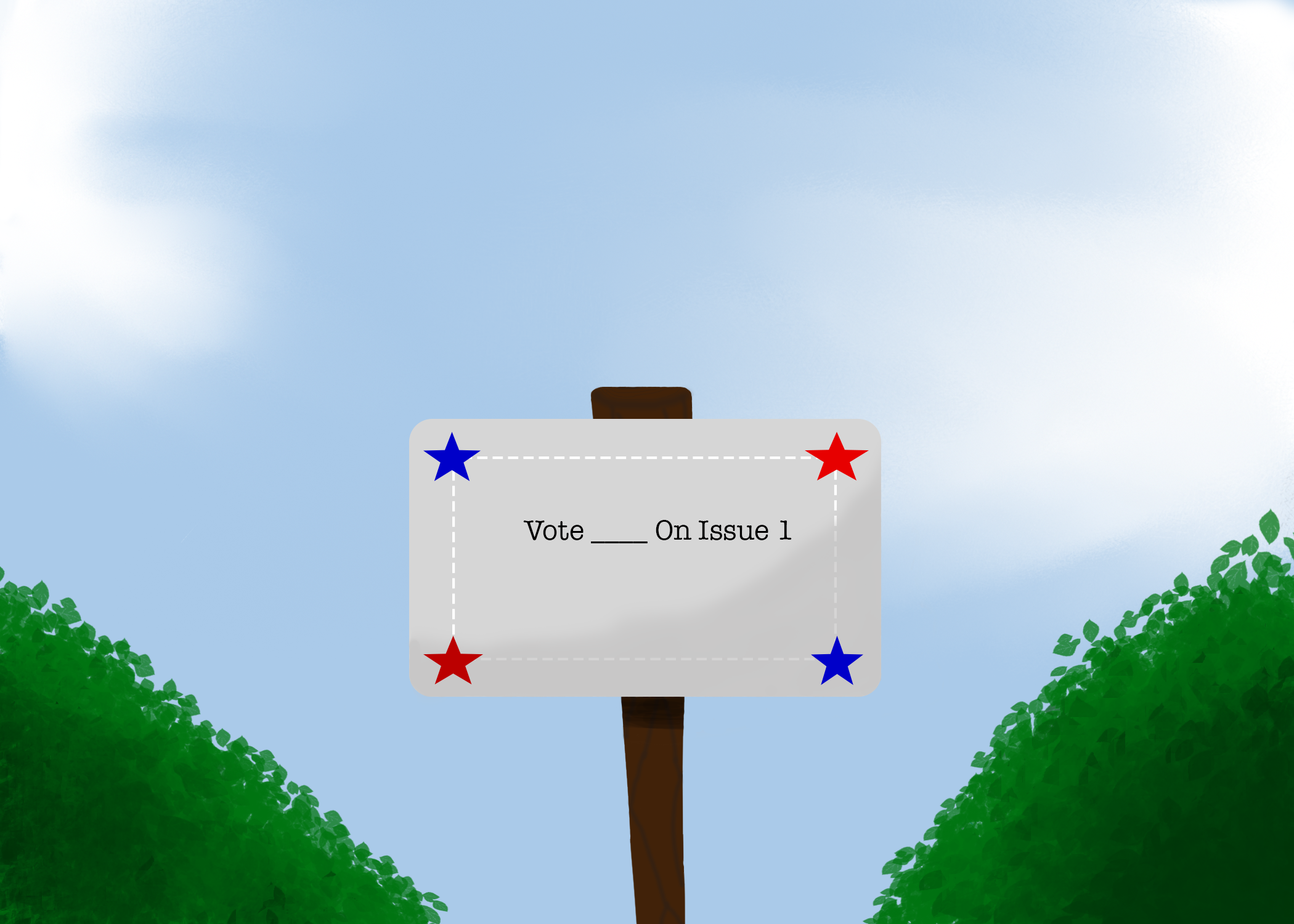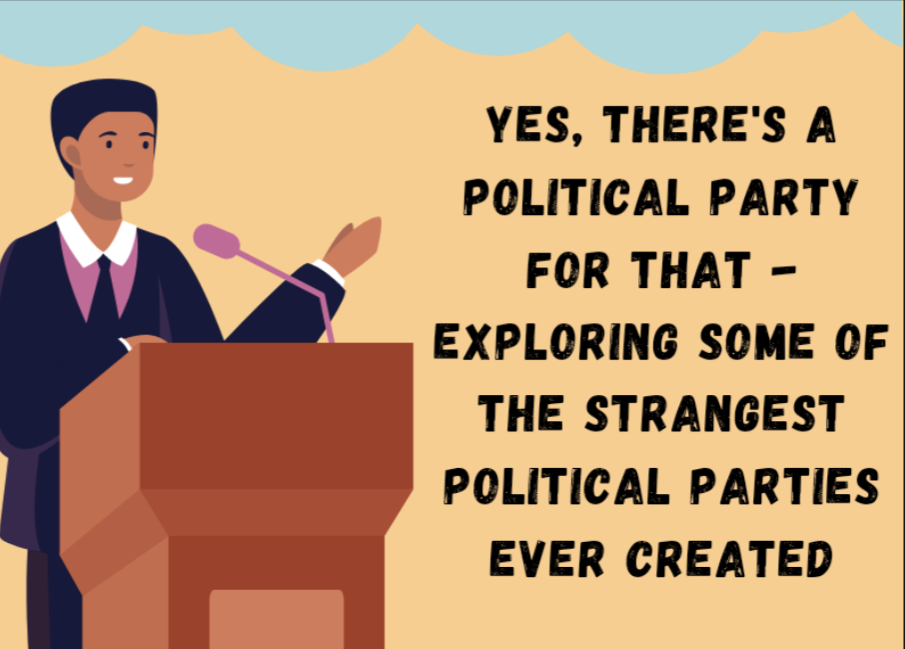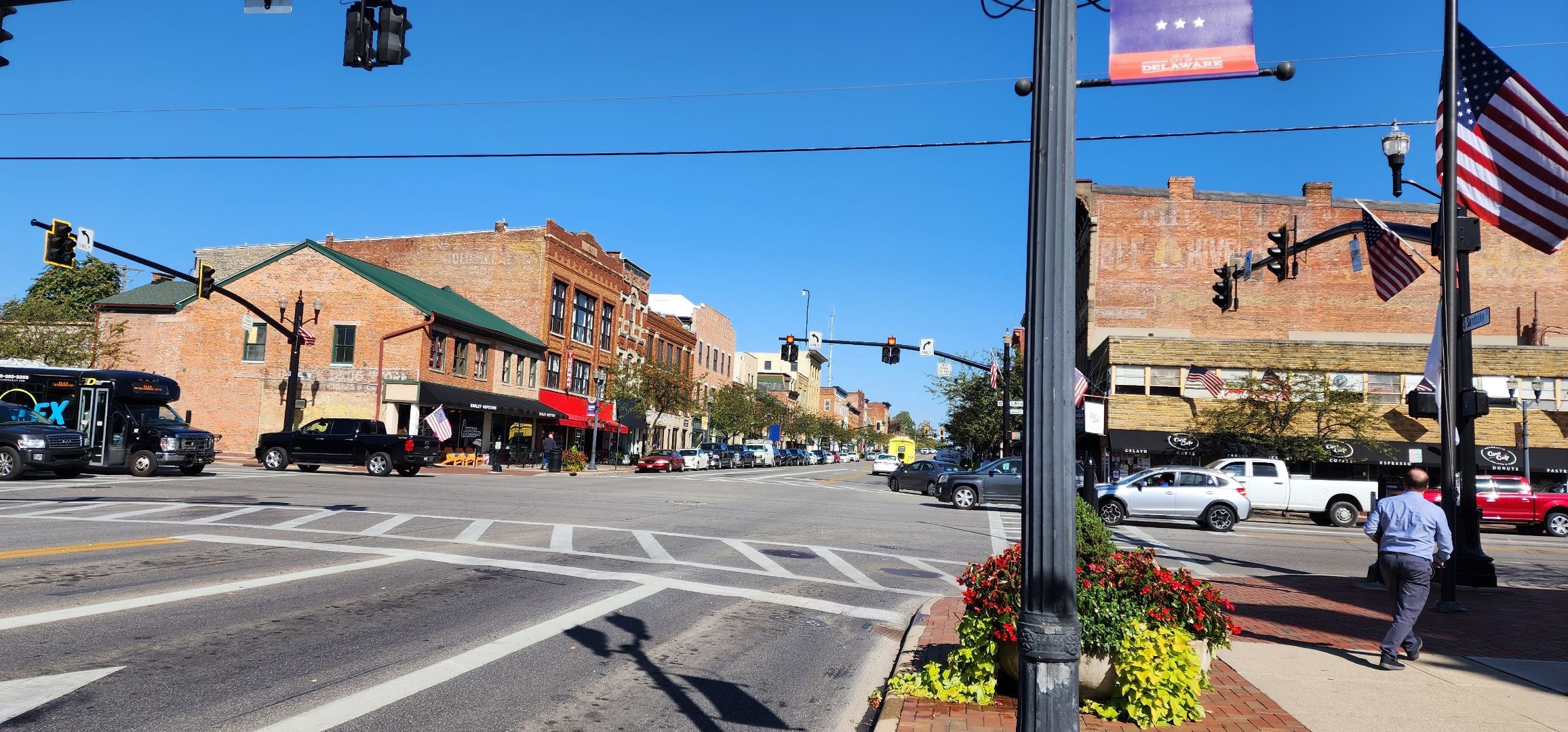Recent news events push conversations about sexual harassment
Photoillustration by Brynn McGrail
Students urge the conversation about sexual harassment. Sexual harassment is an underreported crime.
April 29, 2021
April 2021 is Sexual Assault Awareness Month, and with recent events, young people and girls across social media have encouraged discussions about sexual harassment that often goes unreported.
According to the Ohio Administrative code, sexual harassment includes any unwelcome sexual advances or favors in a physical or verbal manor that impacts negatively on the environment or opportunities in ones work or education.
Nora Flanagan is the Sexual Assault Response Network (SARN) Coordinator at HelpLine and works as an advocate for sexual assault victims in Delaware and Morrow counties.
Flanagan used to work in the felony court system as a victim advocate and currently works in community coalitions with law enforcement and first responders. According to Flanagan, sexual harassment is very underreported because of the lack of understanding by many as to what it is.
“Sexual harassment is a more case-by-case basis, but it really is any unwelcome advances,” Flanagan said. “So, it’s up to the person to determine if it’s unwelcome or not, and especially if they have told the person it’s unwelcome and they keep doing it, usually legally they have grounds of sexual harassment.”
Sexual harassment is often associated with behaviors including sexual requests, discussing sexual relations at work or school, unwanted sexual photos and unwanted touching. Actions like catcalling, leering or jokes in a sexual manner are all considered sexual harassment, while most are often not reported.
“We are not taught what all falls into that category, so when something makes us uncomfortable, we don’t actually know if it is sexual harassment,” senior Harmony West said. “And if we say something and everyone disagrees, then we are made out to be accusers, ruining someone’s life for no reason.”
Many might not report an instance of sexual harassment because of standards in the legal definition.
“Part of the problem is that when you report a problem, they need to fit it with a legal statute,” Flanagan said. “The FBI changed the definition of rape, which is great because it used to say you could only be raped through force, so one would have to prove physical force. They finally redefined rape and it’s a very legal definition.”
The FBI redefined rape to recognize rape by any gender and eliminating the limiting term that it had to be “forcible.” Instead, it emphasizes the lack of consent, noting the standards of consent, excluding consent through intoxication, unconsciousness, deceit or from a minor.
Sexual harassment is not perceived as concrete of a definition as it’s defined from the perspective of the victim, so it is up to the victim as to what makes them feel harassed. For sexual harassment reports to gain any legal ground, the setting is generally in school or work.
According to Ohio law, sexual harassment in the work environment is not tolerated because it is a form of sex discrimination, abiding to Title VII of the Civil Rights Act of 1964. This defends a victim from any quid pro quo sexual harassment used to give one an advantage by sexual means, or any sexual harassment that creates a hostile or disruptive work environment.
In a work environment, hostility is intolerable and includes any unwelcome or offensive behavior.
“A very serious account for me was at a job, and it was really hard for me to address that or talk to an adult about it,” West said. “It’s still very hard because we’re not really taught how to go about it.”
In addition to the work environment, federally funded schools are required to abide by Title IX, which protects against sexual discrimination in education programs. Protection against sexual harassment falls under these obligations.
“It’s not a gray area because it’s a crime, it’s just often unidentified behavior that constitutes sexual harassment,” Flanagan said. “In high school, that school has the responsibility to make sure every single student has the opportunity to learn and if someone is getting sexually harassed, then they aren’t [being given that opportunity].”
Sexual Harassment Education
While students are legally protected from sexual harassment in schools, Flanagan said prevention programs that focus on and discuss these issues in depth are hard to implement into the curriculum.
“The school days are so packed, and a lot of times administrators will weigh things heavier than prevention programs, so often it’s in health class, like suicide prevention programs,” Flanagan said. “I do think that if there’s any time the school could designate just for this kind of thing, that would be great. That means they thought it was that important to do.”
While it’s generally up to each school’s discretion, Flanagan said the statistics make it clear that it’s a prevalent matter by the time kids are in high school, making the conversation especially important at that age.
“If people want to recognize it or not, it’s happening anyway,” Flanagan said. “When we don’t recognize it or at least have an open space, it can cause more trauma and for people to feel more isolated, which can lead to depression, substance abuse – all sorts of things.”
Ohio education standards require health curriculum to include sex-education. But the approaches of sex-education vary across the state. Ohio is one of several states that teaches abstinence-only sex education, in addition to teaching students about venereal diseases.
We learned a little bit about it in middle school, but to be honest I don’t think we talked about it enough. In health class we talk about STD’s and staying abstinent but never a lot about sexual harassment.”
— Natalie Pennington
However, according to a Harvard study from 2017, 87% of young women and teenage girls have experienced sexual harassment. This means most girls will experience sexual harassment before leaving their K-12 education.
Given sexual harassment is so common for young women, many students feel there should be a conversation in schools about sexual harassment.
“We learned a little bit about it in middle school, but to be honest I don’t think we talked about it enough,” senior Natalie Pennington said. “In health class we talk about STD’s and staying abstinent but never a lot about sexual harassment.”
Understanding Situations
Pennington said most of her awareness about the issue has come from social media, where she has also shared her experiences to help educate more.
“I started sharing on social media because nothing was really happening with the situation and it was making me angry,” Pennington said. “A lot of the conversations were very sweet; a lot of people changed their viewpoint on it after hearing me.”
In a situation Pennington experienced this year, she was informed of her legal grounds, which was something she shared about on social media to inform others. Knowing her legal rights in the situation gave her a better understanding of what happened to her.
“The uncertainty really messed with me because I wasn’t sure how to go about it,” Pennington said. “I’ve always been one for labels because it gives me peace of mind, and I can know what it was. I don’t want to call it rape if it wasn’t rape, but I don’t want it call it sexual harassment if it actually was rape.”
Pennington is one of many young people who find themselves confused about how to react to their situation because of the lack of discussion in schools or the media.
“It was a situation where I was like ‘he’s just being nice,’ but then I’m like ‘well I feel uncomfortable so I should be able to say I’m uncomfortable,’” Pennington said.
[Sexual harassment] should be talked about more, so [that] for one, it can be avoided, and two, so if it does happen, you understand it.
— Natalie Pennington
Awareness and education about sexual harassment are important to identifying it when it happens.
“[Sexual harassment] should be talked about more, so [that] for one, it can be avoided, and two, so if it does happen, you understand it,” Pennington said.
Pattern of Victim-Blaming
According to Flanagan, confusion after experiences with sexual harassment is typically assigned with self-blame.
“Our society tends to victim blame, even if we’re getting a little bit better at that,” Flanagan said. “There’s a stigma that the victim did something to deserve it, whether they were in the wrong place or had behavior to welcome this.”
Flanagan said a large part of her practice is to debunk these beliefs and explain to the victim that it’s no one’s fault but the perpetrator, navigating them through their emotions.
The feelings associated with the blame are seen as guilt, shame, loss of power, humiliation and fear. These feelings, while instant, can have long term effects.
“I don’t think people get shamed for, say, getting mugged, but if you get sexually assaulted, now [people assume] you have responsibility for the behavior, but that’s just not the case,” Flanagan said. “It should be treated like any other crime and hold the very basic message that the only responsibility lies with the perpetrator.”
Sexual harassment cases are unique through the perspective of the victim as they are almost always analyzed as the victim’s fault.
“It definitely makes you feel like you need to act differently around men,” West said. “I have to be more conscious about how I dress.”
In situations with interpersonal relationships, victim-blaming is especially common.
“Society or loved ones want to feel that this could not have happened to them,” Flanagan said. “They want to believe there was something they could do to protect their loved ones.”
The common pattern of blame also lays in the roots of society’s gender roles, creating norms for how these victims are harassed and how their reactions are received.
People who identify as women have been taught to be a little more passive or to be polite, whereas men have been taught that aggression or male sexuality can be a badge of honor or something to brag about. Those stereotypes put people in boxes that make this crime more likely to occur.
— Nora Flanagan
“People who identify as women have been taught to be a little more passive or to be polite, whereas men have been taught that aggression or male sexuality can be a badge of honor or something to brag about,” Flanagan said. “Those stereotypes put people in boxes that make this crime more likely to occur. It’s not excused by any means but another emphasis should be on continually debunking stereotypes on what a man is and what a woman is.”
Flanagan noted that while the victims of sexual harassment are predominantly women, it’s still something that happens to men, and because of these same stereotypes, are heavily unreported. She added that the sexual assault rate for transgender women specifically is high.
Education and a clear conversation about sexual harassment is necessary as it impacts everyone, and controls its persistence in the future.
Sharing the Conversation
As part of Flanagan’s work through the hotline, she does something called anticipatory guidance, where she guides a victim through the next steps after a reported instance and explains what reporting a situation would look like.
“Some people choose to report because they want to hold that perpetrator accountable, [and] some people report like a safeguard for the community in case it would happen to others, which is unfortunate they have to feel like that,” Flanagan said.
Pennington said she has been vocal about her experiences on social media for a similar reason.
“It wasn’t just for me, it was for other girls,” Pennington said. “I’m trying to protect other people from going through the exact same situation.”
While sexual harassment and the extent it can reach is a sensitive topic that is difficult for communities and schools to talk about, talking about it could prevent instances of it in the future.
Flanagan said education about sexual harassment is also important for potential perpetrators or anyone who has perpetrated to understand how harmful sexual assault actually is.
A Media-Driven Discussion
Because sexual harassment isn’t often reached in school curriculum, social media has begun to drive the conversation, especially after a recent event in the UK, in which 33-year-old Sarah Everard was kidnapped and killed walking home at night.
With roots from the #MeToo movement in 2017, outrage reached across social media. The alarmingly high statistics of women who have experienced sexual harassment were not surprising to women around the world.
“It’s definitely a part of everyone’s life and it’s really big in my life,” Pennington said. “I think it can be a daily thing.”
The point discussed widely was that Sarah Everard’s story relays back to observations of what she did “right,” including walking a well-lit route and communicating with her boyfriend.
But these precautions were not enough to protect her, and while women can take more precautions as society teaches, people on social media have been urging what they think needs to be taught.
It shouldn’t be up to potential victims to take prevention….the emphasis needs to be on stopping the behavior from the perpetrator.
— Nora Flanagan
“It’s never bad to take safety precautions but basically what we should be saying is ‘do not rape’ and ‘do not sexually assault.’ It shouldn’t be up to potential victims to take prevention,” Flanagan said. “All of that is a little misguided… the emphasis needs to be on stopping the behavior from the perpetrator. That’s the only thing that can stop this.”
Young women and teenage girls have been highlighting on social media the precautions they have been taught to take each day and the fears they face, showing that what happened to Sarah Everard lives in the minds of every girl, everyday.
“It shouldn’t be such a sensitive topic that we can’t get answers on our own personal experiences,” West said. “If we don’t talk about it, it’s going to keep girls more confused when something happens to them, and it gives assaulters more room to do it when that very much can ruin someone’s life.”
Discussing the issues and educating everyone, including victims and perpetrators on the seriousness of this is what’s going to prevent it.
“Not talking about it would just make it harder for people to accept that it happened to them and to actually speak up about it,” West said. “It’s teaching us to silence ourselves.”
Where to Get Help and More Information
At HelpLine, Flanagan and other responders are mandated reporters, but without any disclosing or identifying information, they can not report anything talking to anyone under 18. The hotline is confidential. You don’t have to give any identifying information and do not have to choose to report.
24-Hour Support & Information Hotline: Dial 211 or 1.800.684.2324 or text helpline to 898211
You can reach Nora Flanagan by email at [email protected]
Visit the HelpLine website for more resources and information on any upcoming events.


